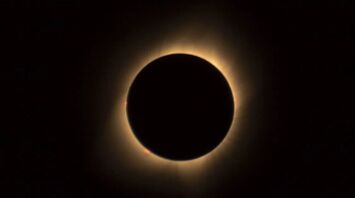Choose a viewing spot and take cloud cover into account: the best ways to see April's solar eclipse

The next total solar eclipse visible in North America will occur on April 8, with the path of the eclipse passing over 13 states and several major metropolitan areas, including Mazatlan, Dallas, Indianapolis, Cleveland, and Montreal.
More than 31 million people already living within the path are expecting this event. Several million more are expected to come to see the spectacle," writes Lifehacker.
There are several scenic parks and remote locations within or near the 115-mile route that can offer an epic spectacle - think Lake Placid and Niagara Falls in New York or Hot Springs National Park in Arkansas - as well as cities and towns from Mexico to Maine.
However, many of these places are already reporting sold-out hotels and exorbitant nightly rates in the few places that have lodging left. If you don't have family or friends who live here, or the time and money to spend a few days traveling to see the eclipse, you may need to consider some alternatives if you want to see it.
Choose a home base near the path of the total eclipse
Obviously, the most spectacular experiences can be had by being in the path of the total eclipse, but so will everyone else. Consider traveling to areas where you can observe the near total eclipse, and that are close enough to be within it if conditions warrant. Possible options include Houston, Texas, Shreveport, Louisiana, and Cincinnati, Ohio. To experience the totality, you need to be within the 115-mile-wide path - being in the center will simply extend its duration.
Big city or remote area
Large cities within or on the edge of the path where the eclipse will be viewed will undoubtedly be extremely crowded. So you may prefer a view from a more remote location. There you will probably have more options for accommodation and easy viewing without having to travel anywhere.
You can also plan to spend the night in the city and go to the countryside for the eclipse itself if you are willing to leave early and are prepared to stand in traffic.
Choose several options for observing
Don't get tied down to one observation site, as it may be difficult to access, too crowded, too much effort due to congested roads, or obscured by clouds on the day of the eclipse. Again, if you haven't already set up a base inside the route, map out several options with highway access and try to choose the one with the best weather forecast.
Estimate the likely cloud cover
One of the reasons why Texas is considered such a popular and crowded eclipse viewing destination is the relatively low chance of cloud cover during a total eclipse, with the best prospects for clear skies expected on the north side of the trail, according to Eclipsophile. While it's difficult to predict weather conditions this far in advance, you can use the forecasts from a few days before the event to determine how much effort you should put in to avoid being disappointed.
Check for road closures
Before traveling, please consider your route, as some roads may be closed for traffic control throughout the day of the eclipse.
Be prepared for along drive
You'll just have to accept the fact that you're likely to spend many hours in the car on the day of the eclipse. Traffic congestion will be terrible, and if you're coming and going on April 8, you can expect it to take much longer than the same route on a normal day. Also, you will spend extra time if you have to drive around to find the best spot. Try to arrive early and consider staying for a while after the eclipse is over.
Fill the car with the necessary things
In line with the above, make sure you have enough food, water, and entertainment for the long hours on the road. You don't want to be stuck in a dead end with no food and nothing to do. For the eclipse itself, bring along eclipse viewing glasses and a chair to sit at the observation site in the hours leading up to the event.



















